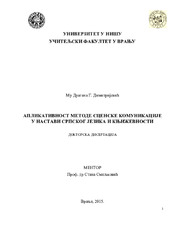| dc.contributor.advisor | Smiljković, Stana | |
| dc.contributor.other | Denić Mihailović, Sunčica | |
| dc.contributor.other | Janjić, Marina | |
| dc.contributor.other | Stanojević, Dragana | |
| dc.contributor.other | Stojanović, Buba | |
| dc.creator | Dimitrijević, Dragana G. | |
| dc.date.accessioned | 2017-01-30T12:23:42Z | |
| dc.date.available | 2017-01-30T12:23:42Z | |
| dc.date.available | 2020-07-03T16:15:00Z | |
| dc.date.issued | 2016-04-13 | |
| dc.identifier.uri | https://nardus.mpn.gov.rs/handle/123456789/7465 | |
| dc.identifier.uri | http://eteze.ni.ac.rs/application/showtheses?thesesId=4482 | |
| dc.identifier.uri | https://fedorani.ni.ac.rs/fedora/get/o:1216/bdef:Content/download | |
| dc.identifier.uri | http://vbs.rs/scripts/cobiss?command=DISPLAY&base=70052&RID=533861270 | |
| dc.description.abstract | The purpose of this research is to determine the effects of implementation of scene communication method in Serbian language and literature teaching, in lower grades of primary school, with the task to improve the quality of teaching.
The methods of research used in this work are: descriptive method, experimental method, comparative scientific - research method and statistical scientific – research method.
The work consists of theoretical part, which said more about the method of scene communication, its techniques and models of playing, as well as the use of informational and communicational technologies for the application of this method.
The results of the research showed that the method of scene communication contributes to more effective and more engaged participation of students in lessons, which led to achievement of better work results. The implementation of scene communication method enables the adoption of contents with maximal thought engagement, personal responsibility, and personal satisfaction, so in that manner, it contributes to achievement of better results, which was all confirmed by the results of this research.
The results gained on the retest of knowledge, carried out three months later, also show that the knowledge adopted from implementation of the method of scene communication, is more permanent. The adoption of contents, where pupils have maximal thought engagement, personal contributes to acquisition of knowledge, as well as to longer remembering of knowledge, also by the pupils who make progress more slowly.
The method of scene communication enables students to show their capability of independent work using their creativity, to get practical knowledge, skills and habits, to develop the culture of speaking, to get productive knowledge and connect it to cognate contents of different subjects.
Children are the principal protagonists in the process of education, and through games they perform their socialization, enrich their vocabulary, enrich themselves empirically, motivate themselves for independent work, become exceptionally creative, and by dosed steps they confidentially go forward.
The method of scene communication permits the minimizing of explanations, and through the move, mimics, game, acting, music, song, imagination, it develops pupils’ creative world, liberates psychological restrictions, shyness, hesitation….
The method of scene communication teaches children how to learn, and how to understand the world that surrounds them. | en |
| dc.format | application/pdf | |
| dc.language | sr | |
| dc.publisher | Универзитет у Нишу, Учитељски факултет, Врање | sr |
| dc.rights | openAccess | en |
| dc.rights.uri | https://creativecommons.org/licenses/by-nc-nd/4.0/ | |
| dc.source | Универзитет у Нишу | sr |
| dc.subject | metod scenske komunikacije | sr |
| dc.subject | scene communication method | en |
| dc.subject | učenik | sr |
| dc.subject | gluma | sr |
| dc.subject | igra | sr |
| dc.subject | mašta | sr |
| dc.subject | the pipl | en |
| dc.subject | acting | en |
| dc.subject | games | en |
| dc.title | Aplikativnost metode scenske komunikacije u nastavi srpskog jezika i književnosti | sr |
| dc.type | doctoralThesis | en |
| dc.rights.license | BY-NC-ND | |
| dcterms.abstract | Смиљковић, Стана; Денић Михаиловић, Сунчица; Јањић, Марина; Стојановић, Драгана; Стојановић, Буба; Димитријевић, Драгана Г.; Aпликативност методе сценске комуникације у настави српског језика и књижевности; Aпликативност методе сценске комуникације у настави српског језика и књижевности; | |
| dc.identifier.fulltext | https://nardus.mpn.gov.rs/bitstream/id/54854/Disertacija7448.pdf | |
| dc.identifier.fulltext | https://nardus.mpn.gov.rs/bitstream/id/54855/Dimitrijevic_Dragana.pdf | |
| dc.identifier.fulltext | http://nardus.mpn.gov.rs/bitstream/id/54854/Disertacija7448.pdf | |
| dc.identifier.fulltext | http://nardus.mpn.gov.rs/bitstream/id/54855/Dimitrijevic_Dragana.pdf | |
| dc.identifier.rcub | https://hdl.handle.net/21.15107/rcub_nardus_7465 | |



